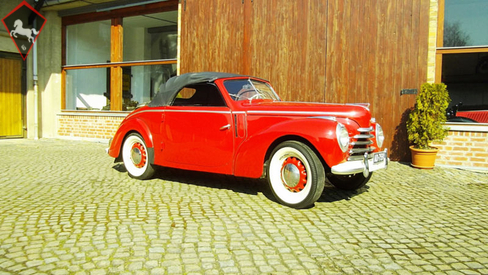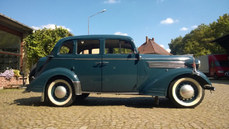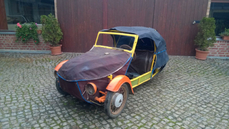Skoda 1101 Tudor ! 1102 Roadster Bj. 1951 1951
General description :
Skoda 1102 Roadster Bj. 1951
Der Skoda befindet sich in einem sehr guten Zustand mit einer schönen Patina. Es handelt sich um eine ältere Restauration. Der Roadster hat die originalen Papiere mit Historie und neue deutsche Papiere.
Umsatzsteuer nicht ausweisbar nach § 25A UStG. Zwischenverkauf und Eingabefehler vorbehalten.
Oldtimerwelt Dresden GmbH
Güterbahnhofstraße 10,
01465 Dresden - Langebrück
Tel.: +49 35201 7755 92
info@oldtimerwelt-dresden.de
https://home.mobile.de/OLDTIMERWELTDRESDEN#des_230124384
1951 Skoda 1101 Tudor ! 1102 Roadster Bj. 1951 is listed sold on ClassicDigest in Güterbahnhofstraße 10DE-01465 Langebrück by Auto Dealer for €39000.
Car Facts
Car type : Car Make : Skoda Model : 1101 Tudor Model Version : ! 1102 Roadster Bj. 1951 Engine size : 1.1 Model Year : 1951 Sub type : Convertible Location : Güterbahnhofstraße 10DE-01465 Langebrück
Sold
Seller Information
Sold
Other cars listed for sale by this dealer
About Skoda
Skoda, the Czech automobile manufacturer, has a fascinating history that spans several decades, marked by both innovation and challenges. Here's a narrative overview, including significant models and the post-war communist era:Early History:
Founding Years: Skoda Auto began in 1895 when Czech entrepreneur Václav Laurin and mechanic Václav Klement started a bicycle repair shop. By 1905, they transitioned to producing automobiles and officially founded Skoda.
Pre-World War II Models: Skoda established itself as a reputable car manufacturer, producing models like the Skoda 422, 430, and 860. These cars were recognized for their quality, engineering, and design, with a few participating in motorsport events.
Significant Models:
Skoda Popular (1934-1946): The Skoda Popular was a significant model produced before and during World War II. It was a compact car known for its reliability and affordability.
Skoda Superb (1934-1949): The Superb was a luxury car that stood out for its advanced engineering and comfort, often used by dignitaries and officials.
Skoda 1101/1102 Tudor (1946-1952): After the war, Skoda resumed car production with the 1101 and 1102 models. These were popular family cars known for their durability and practicality.
Post-War Communist Era:
Nationalization and State Control: After World War II, Czechoslovakia fell under communist rule. Skoda, like many industries, was nationalized, leading to state control and directives in manufacturing.
Soviet Influence: During the communist era, Skoda's focus shifted towards producing vehicles in line with the government's economic plans, leading to standardization and limitations in design and innovation.
Post-Communist Era Revival:
Transition to Market Economy: After the fall of communism in 1989, Skoda underwent significant changes. It entered into a joint venture with Volkswagen in the early 1990s, bringing in new technology, investment, and management practices.
Modernization and Expansion: Under Volkswagen's ownership, Skoda underwent a remarkable transformation. Models like the Octavia, Fabia, and Superb were introduced, blending Skoda's heritage with modern design, reliability, and affordability.
Legacy and Modern Skoda:
Today, Skoda is recognized as a successful European automaker, renowned for producing well-engineered, practical, and value-for-money vehicles. It has gained a reputation for quality and innovation, carving a place in the global automotive market while maintaining its Czech heritage.
The brand's journey from its pre-war excellence through the challenges of the communist era to its modern success with Volkswagen partnership illustrates Skoda's resilience, adaptability, and commitment to automotive excellence.



